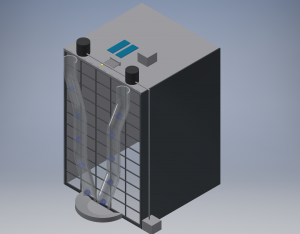
CAD Drawing of design
The Acopian Art Stair Project is centered upon the integration of art and engineering. Our design combines the use of energy and structural technology to create an artistic design that fully utilizes the available natural resources. The defining feature of our project is the use of water as an inspiration for both the artistic and engineering systems. Our project intends to collect rain water and drizzle that water down a large plastic halfpipe on the side of Acopian. While the water is falling, light will be shined through colored glass, refracting off the passing water stream. This system will be powered by sunlight and be self sufficient.
The one constant throughout our project is the flow of water. This water is gathered by rain basins that we will place on top of Acopian. However, the water caught in the basins is not intended to remain on the roof. Before the water makes its way down Acopian it will circulate through a solar thermal heating system on top of the building. This solar thermal system will be relatively simple. It will consist of multiple dark colored plastic tubes. These tubes will be heated by solar radiation. This heating system will prevent the water running through our project from freezing during potential snap freezes during the months of October, November, February, and March. This avoids the potential for system clogs as a result of ice formation within the tubing or other structures.
The water will make its way down to the side of Acopian to the wall face, the most aesthetically important part of the installation. The water will transfer from the rain barrels, where the water supply is stored, stationed on the roof and through
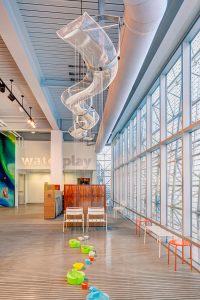
“Rain Meander”. Pittsburgh Children’s Museum. Stacy Levy.
a pipe outward towards the staircase windows. It will then pour the water out along the two clear plastic casts that will take the form of rivers. There will be two of them, the Delaware and the Lehigh or engineering and liberal arts, each 5″ wide and will curve as they make their way down the 65’ wall. The turns will be smooth to allow the water to flow down gently. These casts will appear as if a clear pipe was cut in half vertically and will be made of acrylic or Lexan, as suggested by Stacy Levy. The idea came from one of her projects titled, Rain Meander, that uses a clear plastic cast for an installation in the Pittsburgh Children’s Museum. The casts will have half spherical bumps, approximately 4” in diameter. After testing different flow patterns with Sabatino, we found that shining light through clear plastic that had sizeable dents, the shadow of water flow was most appealing.
Acrylic and Lexan are clear plastics that are flexible, durable, lightweight, and shatter resistant. The differences are that acrylic is clearer, cheaper, and won’t turn yellow however is more likely to crack or chip. Lexan, or polycarbonate, scratches more easily, is more expensive, and could yellow over time but has higher impact resistance and is less likely to chip or crack (A&C Plastics, Inc., 2017). We would need to prototype and test each one to see which would be better for this project, however ran out of time to proceed with testing. These tubes would be made by purchasing the material and molding it into the desired shape or working with the manufacturer to create a design. These would have to be made into smaller sections and then glued together. Both potential materials work well with glue (Emco Industrial Plastics, 2017). Each cast will be supported by vertical stainless-steel rods to hold them up parallel to the staircase wall and connected to footers in the ground. These stainless-steel rods will be attached perpendicularly to the side of Acopian to add support in the case of intense winds or other natural disasters to prevent from crashing into the window. The perpendicular rods will be connected at various levels along the wall to provide the most support without distracting from the overall installation.
As the water travels down the rivers it will pass glass technicolor orbs. These orbs will hopefully be created by Lafayette art students and will be different shades of blue and green to add to the river design. They will be approximately 2’ in diameter and will take on the idea of the inside of a kaleidoscope. The inspiration for these orbs came from artist Olafur Eliasson, an Icelandic artist who’s “practice engages the broader public sphere through architectural projects and interventions in civic space” (Studio Olafur Eliasson).
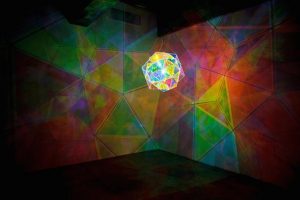
“Infinite color double polyhedron lamp” – Olafur Eliasson
These orbs would be created using stainless steel, color-effect filter glass, and possibly mirrors to reflect some of the light in different directions. Olafur’s design used smaller polyhedrons to create one large polyhedron. Another option for a reflective material could be Dichroic glass which “refers to color-effect types of glass that break up light to varying extents and make the different colors of the light spectrum visible depending on the angle and the type of light source” (Peters, 2014, p. 159). This type of glass is discussed in the book Material Revolution 2: New Sustainable and Multi-Purpose Materials for Design and Architecture, in which it also mentions the resiliency and durability of Dichroic glass. The art students designing these orbs could follow his design or come up with their own creations. These orbs could be heavy, based on the quantity of glass used, but will be supported by the plastic casts and footers. During the day, sunlight will shine through these orbs and then through the translucent casts and create light patterns along the inside of the Acopian staircase. At night, LED lights will be located on the ground and shine on the installation so the installation will be visible in the dark both from the outside as well as the inside. The orbs will be hung on the installation by stringing stainless steel rods through the casts and through the orbs. The rods will be stainless steel because that will hold up with the varying weather conditions of Easton.
The casts will only take up part of the wall, since the wall is about 20’ wide, so for the empty space on the wall decals will be installed. These decals will be similar to what is seen on the side of public buses. They will be on the windows and will be a continuation of the river pattern by appearing as tributaries down the side of the wall.
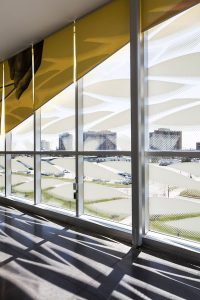
Decal Inspiration
They will be a mix of translucent and frosted and be varying shades of blue. These decals will be bright enough to see them when looking at the side of Acopian from the football field but will also create shadowing on the inside. Each tributary stem will be various shapes and sizes to create a realistic image of tributaries. These shadows will create different blue shadows and patterns inside the Acopian stairwell as the sun shifts throughout the day. Each window not covered by the cast will have its own decal. When walking up the stairs, students will be able to see the overall river and tributary system flowing down the staircase windows and will be greeted with blue shadows and light, watching the rain water run down to the ground.
The plastic half tubes containing the colored orbs will need to be secured to the wall to prevent swaying in the wind. A frame that uses the existing structure of the glass will need to be installed to keep the tubes in place, as well as support them. A structural analysis will need to be conducted to ensure that the tubes and orbs to not put excessive strains on the building. Since the windows have panes, the wall could be drilled into to attach supports, otherwise it would be very difficult to make the structure free standing.
To support the frame providing stability to the installation along the window, footers would need to be placed in the ground. Typically made of concrete with a rebar reinforcement, footers are an essential part of a support system. In order to install the footers, excavated trenches would need to be dug at the base of the installment, and the concrete poured in. The support structure would then be placed on top of the footers. Footers are especially important in areas that have particularly soft or troublesome soils, since settling could more easily occur.
The length, width, and placement of the footers are all very important and depend on several factors. First and foremost, the size and weight of the structure must be taken into consideration. Acopian spans six stories, and so the footers will need to be able to support a structure that reaches to this height. However, the art installment will weigh much less than a typical building, so the footers will not need to be the equivalent size as those for a six story building. The soil quality is another factor that affects the footers size and placement. Footings spread out the weight of the structure so the soil can carry the load (Concrete Network, 2017). According to Concrete Network, “The load spreads out within the footing itself at about a 45-degree angle, and then spreads out in the soil at a steeper angle, more like 60-degrees from the horizontal.” (Concrete Network, 2017). Spreading the load out puts less pressure on the soil, except for the soil directly under the footer, which needs to be tightly compacted after excavation to avoid extra settling. The type and density of the soil are important when designing the footer because different soils will respond differently to the load. Therefore, in order to properly install a footer to support the art installment, the soil under the pavement surrounding Acopian needs to be analyzed to ensure that the structure remains standing.
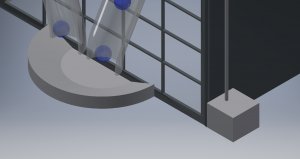
CAD Drawing: Water collection and pump.
As the water flows down the plastic half tubes, supported by the frame relying on the correctly placed footers, it will eventually reach the bottom of the installment. Here, it will be collected in a retention tank. The tank will hold the water, and allow it to be pumped up and back through the installment. The tank will need to be sufficiently large to hold the volume of rainfall typically expected in Easton. It will need a spigot to drain in case of maintenance purposes, and should be designed to keep out any insects or animals. The tank will also need to have an overflow system, in case of unexpected rainfall. To divert overflow water, a drainage swale will be installed to carry water away from the building and surrounding parking lot. A drainage swale is typically shallow rock filled basin with gently sloping sides (This Old House, 2017). The swale can be surrounding by plants, or have plants down the center (This Old House, 2017). The plants help to absorb the excess water, while the rocks divert the water away from the building.
The water moved up the side of Acopian using a hydraulic pump. This pump is required to move the water at a flow rate of 2 m^3/h. Using the ideal flow equation Ph(kW) = q ρ g h / ((3.6)106), we found that pumping the water 21.6 m up Acopian’s stairwell wall would require .138h(kW), assuming a pump efficiency of 85% (Lysen & Hulle, 1982, p. 56). Using the Waterway Iron Might Pump as an example, our theoretical pump would have a voltage of 115 V (“Spa Guts,” 2017).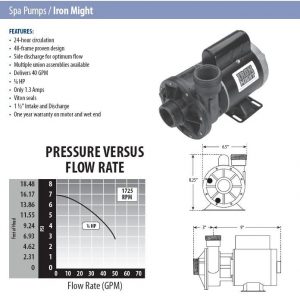
In an effort to make the water pumping system clean and self sustained we plan to power the system using solar panels to be placed on the roof of Acopian. With a solar resource of 4.2 KWh/m^2/day Easton has a slightly high level of solar energy than the average US town. In order to intercept the most possible solar energy, the solar panels would be placed at the optimal angle for their latitude, which would allow them to intercept approximately 4.57 kWh/m^2/day. With a energy efficiency of about 15%, polycrystalline panels would be the most likely type of solar panel to be used in the limited available area on the roof. Using the equation “(4.57kWh/m^2/day)(.15)(1/24days/hr) = installed capacity”, we know the system would have an energy capacity of about .02856 kWh/m^2/hour (Lysen & Hulle, 1982, p. 56). This capacity indicated that we would need to install at least 3.15 m^2 of polycrystalline panels in order to power the pumping system.
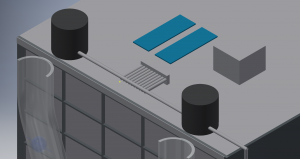
CAD Drawing: Solar Panels, Solar Thermal, Rain Barrels, Storage Module
If we want the system to operate in times of low sunlight, the solar panels would have to store the energy that they gathered before it could be used to power the pumping system. Because we are using solar energy, the panels would only be gathering energy for less than half of the day. Assuming this battery or solar storage module would need to store approximately a day’s worth of energy, we would need a battery with approximately a 1.0 kWh storage capacity. However, if the water was only set to run for a portion of the day, a smaller, more reasonably priced battery or no battery could be used instead (Lysen & Hulle, 1982, p. 55).
Because our system is self sufficient, water will repeat the cycle of pouring down the display as long as their is enough of a solar resource. In this way the water levels of the system will gradually build up to the point where drainage will occur every time it rains. This is when the installed swale will become particularly necessary. Ideally, the result would be a design that needs little maintenance and positively impacts the surrounding environment.
